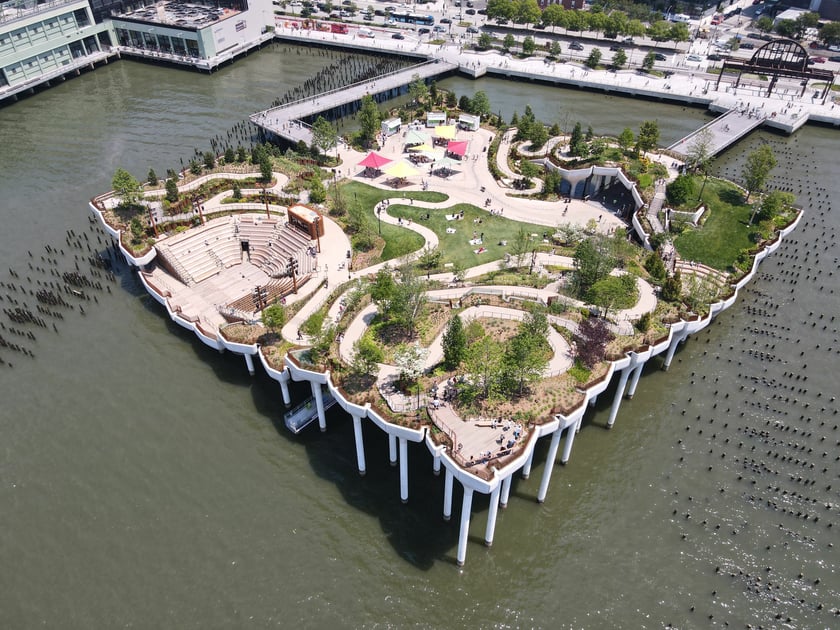What Fairy Princesses Can Do for Your Design and Marketing Strategy: Supercharging Your User Experience by Designing for Play
March 28, 2024 at 3:36 PM

Is anyone up for a game of make-believe? Or should we perhaps break out the Pokémon cards? Maybe not so much – but believe it or not, your design and marketing strategy have much to learn from a humble game of fairy princesses.
Play is More Important Than You Think
Most of us assume we've grown out of play, but that couldn't be further from the truth. According to author Kristin Wong, play is any activity "that's imaginative, self-directed, intrinsically motivated and guided by rules that leave room for creativity." It generally isn't productive in any traditional sense – rather, the primary outcome is your enjoyment. Watching movies, playing pickup soccer, crocheting, rock climbing with friends after work, placing your bets for March Madness, debating, running to beat your best mile time, building LEGO sets, baking sourdough, or going to book club… you play, too. It's just grown up with you. And all that play is more important than you might think.
See, playfulness is wired into us. Not only is it a universal human behavior – it’s an innate part of being an animal. Play shows up all over the animal kingdom, from rats to macaques to octopuses, indicating it serves a deeper purpose in our cognition than enjoyment alone. Another clue to its importance is that, according to neuroscientist Ryan P. Dalton, “failing to [get enough] can result in inappropriate aggression, anxiety, and social isolation.” But you probably didn’t need a neuroscientist to tell you that all work and no play is a well-proven formula for poor mental health.
So, we know it’s part of us, but why? The benefits of play are varied and extensive – a few of the most accepted theories are that it allows us to “practice” for real-life problems we might encounter, teaches and reinforces social behavior, and encourages us to explore our environments – but the upshot is that play is good for us. According to an article from Psych Central, adults who play indicated better mental health habits than their peers who play less, with higher rates of play tied to lower stress and stronger skills in positive reframing, engaging in curiosity, and finding joy and excitement in life. Play also encourages exercise since people are more motivated by the prospect of participating in a game than burning energy for energy’s sake. It’s clear that we don’t choose to play. Rather, as Dalton explains, “we play because it is in our nature to do so.”
Designing for Play Isn’t Just Fun, but Powerful
If play is such a key factor in our innate behavior, why doesn’t it take higher precedence in design? We often create our environments – our offices, public spaces, websites, and brands – for productivity, efficiency, and cleanliness. And yes, these factors are important. But so is play, and rarely do we intentionally incorporate opportunities for it, perhaps because it’s long been considered frivolous and unnecessary beyond childhood.
With more research coming out by the day backing up the contrary (and vindicating a deep-down belief about the importance of play I think most of us hold), it’s time to shake up the old order. If people need play, why not give it to them? Your design affects real people’s lives and well-being, so it should be structured to accommodate peoples’ innate behaviors and needs – play being one of those.
Now that we’ve covered what play offers us let’s return to your design and marketing strategy and where exactly that game of fairy princess factors in. We all seek to be here for our users, offering what they need when they need it. Well, we all need play – and not only does it make for healthier and happier users, but people have intensely positive associations with it. For this reason, playful experiences can be an invaluable component of your brand and inbound marketing strategy, from attraction to engagement to delight.
Out of the gate, play offers an excellent way to attract leads since people seek out opportunities to play of their own volition. Even the smallest promise of a playful experience can be an almost irresistible impetus for potential leads to investigate your marketing or services – think about the times you’ve been drawn into a brand by a cool pop-up experience or a playful interactive website. Once your leads are interested, the game begins. Engaged and enjoying themselves, your leads stick around to play, absorbing what your brand is all about. By the end of the experience, your users leave stimulated, fulfilled, delighted, and excited to return. Play, after all, is intrinsically motivating. So, by incorporating opportunities for play into your company presence, you cultivate a brand that people are inherently motivated to seek out, engage in, and come back to time and time again.
How to Get Your Head in the (Design and Marketing) Game

So, in practice, how do you begin incorporating design for play into your strategy? The key is to focus on providing delight and giving people space for self-directed exploration and engagement. This can happen on a large or small scale, from play being the backbone of an experience to subtle moments of engagement. To get your gears turning, here are a few examples of instances in which designing for play has proved an effective way to attract, engage, and delight users:
Public Spaces that invite playful interaction
Spaces like New York City’s Little Island Park, designed by Heatherwick Studios, encourage self-directed play and exploration. Hovering above the Hudson on tree-like concrete pillars, the two-and-a-half-acre park features plenty of opportunities for adults and children alike to explore. The winding pathway that encircles the park loops up, down, and around itself, diving into tunnels and rising to the park’s highest point for a view of the city. It even features shortcuts on switchbacks, not just allowing but encouraging park visitors to clamber up the hillsides hand over hand should they like to. Public instruments such as dance chimes are scattered around the park, and in the summers, musicians come to play in the central courtyard, giving people a chance to dance or gather for the music. The park has been a huge hit, bringing around 17 million visitors to the Hudson River Park annually. However, the same tenets that make playful physical public spaces can also create engaging digital ones on a fantastic display on the Hong Kong Design Institute's website. Instead of navigating traditionally, visitors use their keyboard and mouse to move as if in a video game, organically exploring the HKDI's Dream Factory that houses sections of the site’s content. In both cases, the sum effect is a space where all are welcome to let their guard down and engage with their surroundings self-directedly, inspiring delight and repeated visits.

Unexpected moments of delight in brands
Play doesn’t have to be the main driving factor in a brand or experience to be effective; it can be sprinkled in in little ways. Google is a great example of a brand that provides small moments of play and delight to great positive effect. For instance, the constantly changing Google Doodle provides users with a serendipitous chance to enjoy a creative piece of artwork and click through to learn something new, perhaps even to play a video game. The Easter eggs embedded throughout their code – there are hundreds, but to get an idea if you’ve never tried before, try googling “do a barrel roll,” “Grogu,” or “meteorite” – similarly provide unexpected delight and encourage further engagement. Apple’s weather app is another example of an experience that provides these micro-moments of delight. Building the app with a dynamic background that displays current weather conditions – featuring animated snow, rain, thunderstorms (with lightning bolts even occasionally striking in front of the text on the screen), and even sunrises and sunsets – leaves users delighted and happy to poke around to explore the app further.
Small moments of joy can also be expressed in print designs. Fun and creative print designs can bring a touch of delight to receiving mail or browsing through an annual report. For instance, look at this cover page, which is a metaphor for involvement and support that encourages the reader to interact with our client, the American Academy of Periodontology Foundation (AAPF). You can also check out another one of our interactive experiences that includes puzzle pieces, a workbook, and a set of cards designed to encourage employees to take advantage of Kraft's Work/Life Solutions.

Immersive marketing experiences
Experiences such as pop-ups and alternate reality games (ARGs) let users engage with a brand in a personal and compelling way. The marketing team for Barbie (2023) employed pop-up experiences decked out in the aesthetic of the film to get audiences excited, setting up a “Barbie Dream House” in Malibu that could be rented out on Airbnb and pop-up “Malibu Barbie Cafes” – featuring food, drinks, a roller skating rink, and plenty of photo ops – in cities across the United States. In 2018, Westworld brought the immersion to a whole new level, setting up a replica of the show’s titular theme park in Austin’s SXSW festival that let fans experience the world of the series for themselves. However, such experiences need not be strictly physical. ARGs leverage the power of the internet to generate hype for upcoming content by pulling users into an immersive digital scavenger hunt, scattering clues for players to find across various websites and social media accounts. Notably, both the TV series Lost and the video game series Bioshock successfully used ARGs with The Lost Experience, and There’s Something in the Sea, respectively. Fans could untangle the mystery by following a trail of clues, ultimately discovering bonus lore about each fictional world. In either format, inviting users to participate in the world of the brand creates personal investment. Not only does this make for a fun user experience, but it also creates strong memories and associations of enjoyment with the brand, building a loyal customer base.
Now, Get Out There — and Remember to Have Fun!
When thinking about implementation, it’s important to be creative – just because your brand or product isn’t compatible with a full-scale pop-up doesn’t mean you can’t work in play in other ways, such as an interactive email campaign, an unorthodox website design, a team-building design experience, or an Easter egg, like putting your brand mascot on your employee page. Your customers will enjoy it as long as you do too.
To wrap it up, there’s a lot to gain from design for play. Not only is it good for us, but it’s also an incredibly effective tool for engaging people with your brand. By incorporating play into your design and marketing strategy, you can create a mutually beneficial experience for you and your customers – no magic wand required.
Comments
Questions or comments? Join the conversation!